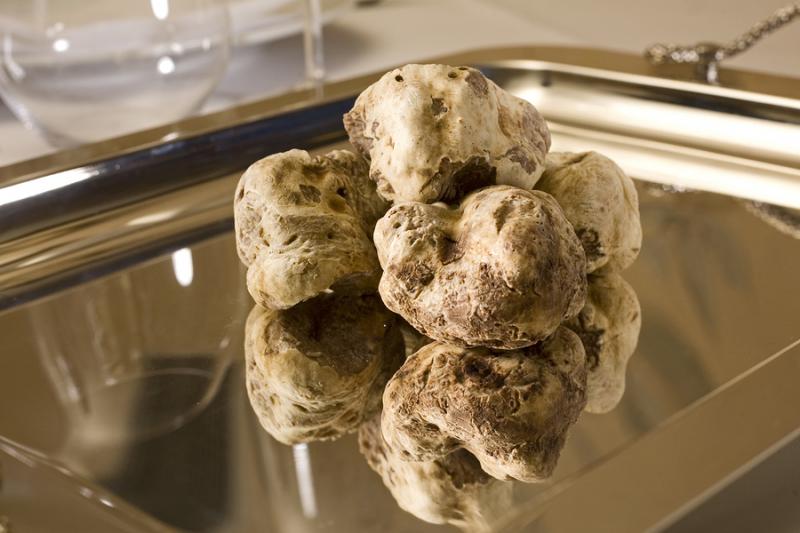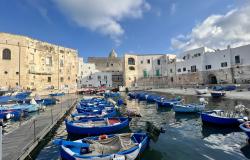As we enter the season for the most prestigious truffle, Piedmont White Truffle, we look at the king of the culinary world and describe some of the main varieties and characteristics of this rare, edible mushroom with an intense aroma and characteristic flavour that give it its fame as one of the top gourmet delicacies you should try at least once in your life.
What are truffles?
You can describe a truffle as a mushroom growing underground and playing hard to get.
As a matter of fact, it is a subterranean fungus, growing in proximity of trees' roots that can be difficult to harvest because it can be found between 5 and 30 cm below the ground; this is also why they are usually harvested in the wild by trained hogs and dogs.
Truffles form a symbiotic, mycorrhizal relationships with the roots of several tree species, primarily beech, poplar, oak birch, hornbeam, Hazel and pine and prefer argillaceous or calcareous soils which are well drained and neutral or alkaline. They fruit throughout the year, depending on the species, and, unlike above-ground mushrooms, don’t grow stems and caps. This means that the spore-bearing part of the truffle is fully enclosed and dependent on animals, like squirrels or chipmunks, to help spread the spores above ground.
The origin of the word truffle appears to be the Latin term tuber, meaning "swelling" or "lump", which later became tufer and gave rise to the various European terms, like the Italian word Tartufo.
In Italy, the prized black and white winter truffles are found in Umbria, Piedmont, Emilia Romagna, Tuscany, Lazio, Abruzzo and Molise.

What is the shape and colour of truffles?
Truffles may vary in colour and shape. The main differences do not depend on the age of the truffle, but mostly on the type of soil where they grow. Colour can go from white to gray or brown. But they can also take on shades of pink.
They can have a smooth or wrinkled surface depending on the species and are formed by an outer layer (Peridium) and by an internal pulp (Gleba).
How many and what types of truffles are there? In what do they differ?
Though there are hundreds of different species, only some — mostly of the genus Tuber family— are considered delicacies of interest to gourmets.
They are usually classified according to their appearance, smell, and taste. Found in a variety of regions around the world, many are commonly known with the name of the location where they grow rather than their technical name. Their value varies depending on their rarity and specific aromatic qualities with the rarest being the most expensive food in the world.

One of the most rare kind of truffle is actually the Tuber magnatum, the Italian white or Piedmont truffle, also known as "White Diamond", famous for its strong flavour which often hits the headlines when sold at the international auction for incredible prices.
Here's a look at the different varieties of truffles, from the least to the most prestigious:
- Tartufo di Bagnoli - Tuber Mesentericum

Unappetising and little appreciated, it has a strong unpleasant smell.
Shape and colour: It has a more regular shape, with a black or brownish skin with smaller warts than Tuber aestivum. The flesh is yellowish, brown or gray-brown.
Aroma and taste: It smells like bitumen or phenol and has a bitter taste, usually not pleasant.
It grows in symbiosis with oak, hornbeam, beech, maple and hazel trees.
- Tuber Brumale - Black Winter Truffle

This looks quite similar to black truffles, but with a less distinct aroma, it is by far not as valuable. Winter truffles are usually a bit smaller, but the main features that distinguish them from authentic black truffles are the less intense aroma and the rougher and lighter veins. As both these varieties of truffle are available at practically the same time, a trustworthy truffle dealer is essential.
Tuber brumale, like its Muscat variety, is a truffle that can grow in many different environments, and can be equally found in the mountains, hills and plains. It has no particular requirements in terms of climate, but grows in area where the earth is at least a medium-depth, so it is also known as "nero di campo" (black truffle that grows in the fields).
Shape and colour: The rind is black with slight low and flattened warts. The gleba is gray or brownish with white veins.
Aroma and taste: They have a pungent and less intense aroma than that of other black truffles, but their taste is quite pleasant.
They grow in symbiosis with hazel, oak, beech and hornbeam trees. They can be bigger than an egg.
Harvest: from January to March.
- Tartufo Moscato - Tuber Brumale Moschatum

It differs from the common Brumale variety because of its intense musky aroma that gives it its name.
Shape and colour: The rind is black with slight low and flattened warts. The gleba is gray or brownish with white veins.
Aroma and taste: They have a spicy intense, sweet muscat wine aroma and taste.
They grow in symbiosis with hazel, oak, beech and hornbeam trees. They can be bigger than an egg.
Harvest: They can be found between February and March.
- Tartufo Bianchetto or Marzuolo - Tuber Albidum Pico

These truffles have a smooth whitish skin, so their peridium is confusingly similar to that of the authentic white truffle, but are not as aromatic and therefore less appriciated than white truffle. Luckily, they do not ripen at the same time of the year, so there should be fairly limited risks to confuse them with the Piedmontese white diamonds.
Shape and colour: They are smooth and pale-white and the fruit layer is brown with rough veins.
Aroma and taste: It has a very distinct (but not so intense) aroma - rather sharp and garlicky and not as complete as that of the the real white truffle.
They grow in symbiosis with oak, beech, pine and larch trees.
Harvest: From February to April.
- Tartufo Nero Liscio - Tuber Macrosporum

This species is rarely found. Usually, they grow in the same area where tuber magnatum grow and can withstand periods of drought. This species has the characteristics to grow several truffles in the same hole.
Shape and colour: reddish brown skin with warts and a whitish brown pulp which later becomes rusty-brown.
Aroma and taste: They have a similar aroma to that of white truffles, but with stronger garlicky taste.
They grow in symbiosis with oak, hornbeam, poplar, willow trees.
Harvest: Between late summer and autumn, in particular between August and September.
- Tartufo Estivo o Scorzone - Tuber Aestivum - Summer truffle

This is the most common type of truffle found in most European countries. The flavour, size and colour of summer truffles is similar to that of burgundy truffles, but their aroma is less intense and the flesh is a paler hazel color. Due to its relatively good availability and to the similarity in taste with regular mushrooms, it has a lower price, well below that of the authentic black truffle. The quality is very good even if it does not attain the aroma of the authentic tartufo nero pregiato.
Shape and colour: They have a round, irregular shape with brown or black outer skin and pyramidal warts about 3 to 9 mm wide, resembling rough bark. Their flesh can be light hazelnut or brown.
Aroma and taste: The aroma is more delicate than the one of other black truffles and the taste is similar to that of porcini mushrooms.
They grow symbiotically with oak, hornbeam, pine, ash, beech and hazel trees.
Harvest: summer truffles are usually at their best in July, but can be found from May to October.
- Tartufo Nero di Fragno - Tuber Uncinatum - Winter Scorzone

It belongs to the family of Tuber aestivum , is very well known in France as Burgundy truffle.
Shape and colour: They are very similar to the Tuber Aestivum but with smaller warts and a much darker flesh.
Aroma and taste: They have an intense, hazelnut-like aroma.
They grow symbiotically with oak, hornbeam, pine, ash, beech and hazel trees.
Harvest: These truffles are harvested from September to late December, sometimes also until late January.
- Tartufo Nero Pregiato - Tuber melanosporum vittadini - Black Truffle

These are the second-most commercially valuable species of truffle and the most prized among black truffles. They are also known as sweet black truffle for their exquisite taste and in Italy as tartufo nero pregiato and often as Tartufo di Norcia, as the best authentic black truffles in Italy comes from around Norcia in Umbria.
Shape and colour: They have a round, dark brown fruiting body and a black-brown skin with small pyramidal cusps. Their flesh is initially white, then turns gray- brown or reddish black. It is permeated by white veins which turn brown with age.
Aroma and taste: They exude a scent reminiscent of undergrowth, strawberries, wet earth or dried fruit with a hint of cocoa. Their delicate peppery taste fully develops after the truffles are gently heated.
They grow symbiotically with oak, hazel and hornbeam trees and normally reach a size of up to 10 cm.
Harvest: Depending on the areas, from mid November to mid-March.
- Tartufo Bianco - Tuber Magnatum Pico - White Truffle

The very rare Italian white or Piedmont truffle, better known as the white Alba-truffle, is the type with the most intense aroma. It is the most expensive and thus the most luxurious food in the world. The biggest truffle of this type was found in 1954 and weighed 2.5 kilograms and was given as a present to President Truman.
Shape and colour: They almost always are irregular in shape, with a smooth dirty beige surface that ages to a brown. The colour of their flesh is solid, light-coloured, and very brittle and varies from milky white to deep pink, depending on the age of the tree with which it is in symbiosis.
Aroma and taste: musky and earthy with notes of garlic, honey, butter, and forest floor. The flavor is more pronounced than that of black truffles and it is more perishable. They should be eaten within a week of being harvested. It ranges from walnut- to apple-size, weighing up to 1 pound (0.45 kg).
They are eaten raw in small quantities mostly grated over pasta, risotto, eggs, salads or meat dishes, only a few grams can give a very distinct flavour to any recipe.
They grow symbiotically with oak, hazel, poplar, willow and beech trees. They can reach 12 cm (5 in) diameter and 500g, though are usually much smaller.
Harvest: The white truffle season starts at the end of September, but they reach their peak in October and November. It is illegal to sell them before September to ensure quality.
How to store truffles
Ideally, truffles should be used as fresh as possible, however, if you cannot use them straight away, they can be stored for several days (from 6 to 8 days) in a paper bag or clean towel (never in plastic or aluminium foil) in the refrigerator. Before storing them, clean them using a soft brush to remove the soil and other impurities and, for a better result, change the paper bag or towel every day.

They can be immersed in olive oil, and the oil will absorb the flavor, however shelf life at room temperature is limited without pasteurization. Traditionally, many people keep truffles in glass containers filled with dry white rice, but this is not recommended as the rice grains tend to draw the moisture and aroma away from the truffles, diffusing and diluting the aroma.









